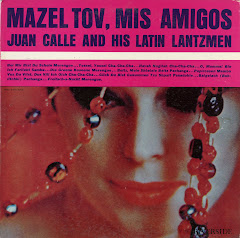 recording of a Jewish prayer service. Yet as so many of the LPs we gathered seemed to suggest, Black women artists played a key role in all these exchanges. We stumbled on Eartha Kitt doing "Sholem" and "Roumania, Roumania" (see our earlier post) and Billie Holiday doing "My Yiddishe Momme" and Ethel Waters doing "Eli, Eli" and Alberta Hunter taking a trip to Israel and coming back to talk about it on the Dick Cavett show in 1979 where she proudly sings the old Alexander Olshanetsky tune "Ich Hob Dich Tsufil Lieb." She does it all in Yiddish instead of in its better known English version as "I Love You Much Too Much."
recording of a Jewish prayer service. Yet as so many of the LPs we gathered seemed to suggest, Black women artists played a key role in all these exchanges. We stumbled on Eartha Kitt doing "Sholem" and "Roumania, Roumania" (see our earlier post) and Billie Holiday doing "My Yiddishe Momme" and Ethel Waters doing "Eli, Eli" and Alberta Hunter taking a trip to Israel and coming back to talk about it on the Dick Cavett show in 1979 where she proudly sings the old Alexander Olshanetsky tune "Ich Hob Dich Tsufil Lieb." She does it all in Yiddish instead of in its better known English version as "I Love You Much Too Much."When Lena Horne-- a veteran of plenty Hadassah benefits in the States-- went to Israel in 1952, she sang some Israeli tunes she had learned phonetically over the years. Israel was in the midst of independence fever and Horne was taken by what she called "history-in-the-making in a brand-new country." She visited kibbutzes and a camp for Yemenite children, "terribly oppressed people of color, people just emerging from the kind of bondage Negroes have been struggling so long to emerge from." Nearly a decade later, in the midst of U.S. civil rights upheavals and inspired by the folk protest scene, Horne went through a career transformation and decided she needed to start singing political songs. Harold Arlen and Yip Harburg wrote her "Silent Spring" (based on Rachel Carson's influential book on environmental destruction) and Broadway vets Adolph Green, Betty Comden, and Jules Styne wrote her "Now!," an incisive rant against civil rights abuses that Styne cpmposed, believe it or not, to the cheery tune of "Hava Nagilah." Horne performed them both at a SNCC rally at Carnegie Hall. Then as film scholar Michael Renov thankfully revealed to us-- in 1965, "Now!" became the soundtrack to a pioneering experimental documentary about the civil rights movement by Cuban filmmaker Santiago Alvarez. Must be seen and heard to be believed.
 Nina Simone played Israel in the 70s and was shocked to find that when her El Al fight landed at the Tel Aviv airport, there were throngs waiting to see her. "They had been waiting for me to come for ten years," she wrote in her autobiography. Simone left Israel in 1979 and claimed that her visit put her back in touch with herself and with God and put her career back on track. She should have seen it coming-- Nina already had Israel on her mind in the 60s. She sang the circle-dancing ode to the Land of Milk and Honey, "Eretz Zavat Chalav," when she played Carnegie Hall in 1963. You can hear it on her incredible live LP Folksy Nina, or just be awed by this:
Nina Simone played Israel in the 70s and was shocked to find that when her El Al fight landed at the Tel Aviv airport, there were throngs waiting to see her. "They had been waiting for me to come for ten years," she wrote in her autobiography. Simone left Israel in 1979 and claimed that her visit put her back in touch with herself and with God and put her career back on track. She should have seen it coming-- Nina already had Israel on her mind in the 60s. She sang the circle-dancing ode to the Land of Milk and Honey, "Eretz Zavat Chalav," when she played Carnegie Hall in 1963. You can hear it on her incredible live LP Folksy Nina, or just be awed by this:



















+img037+copy.jpg)




